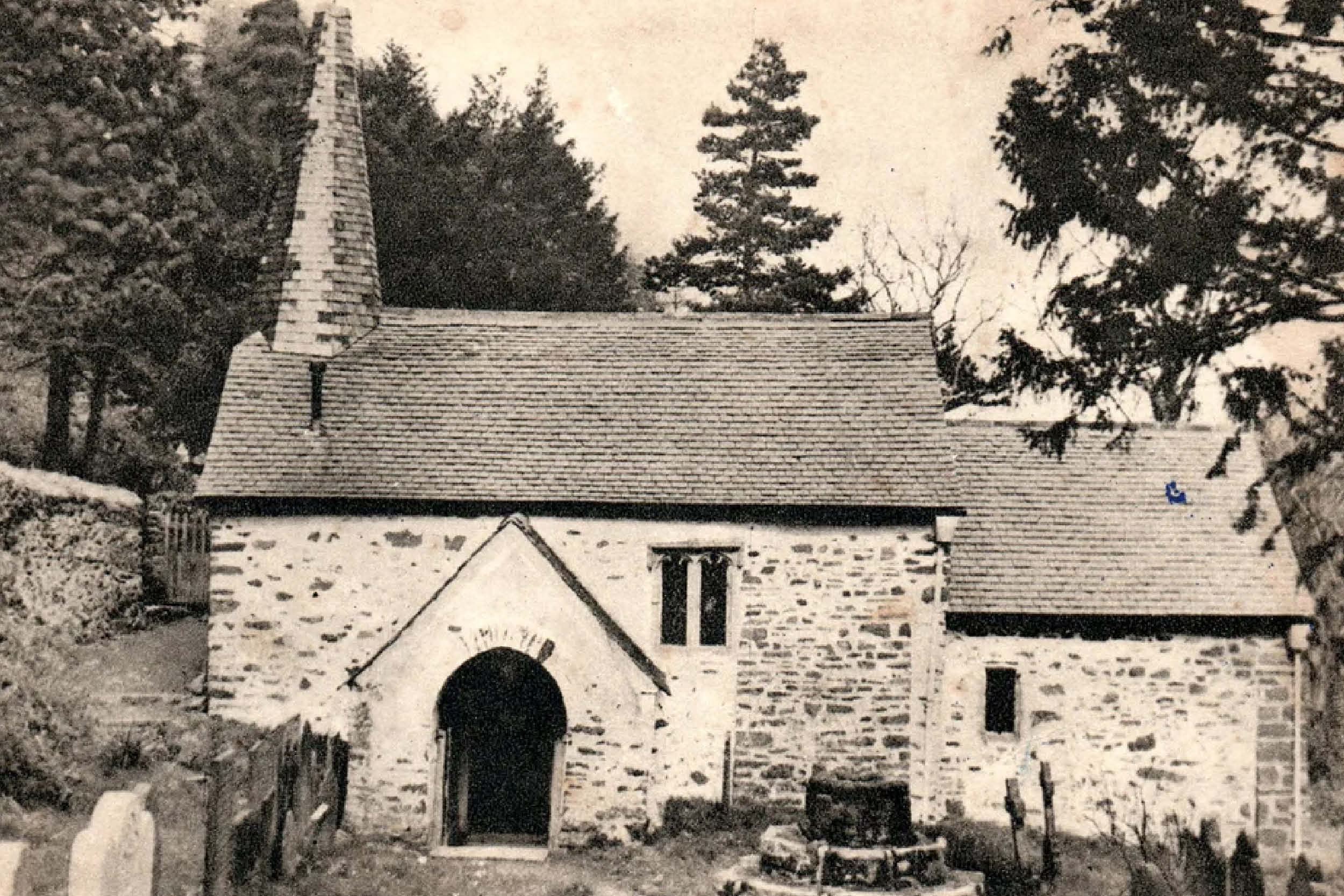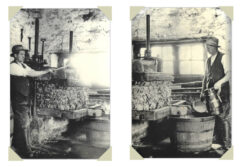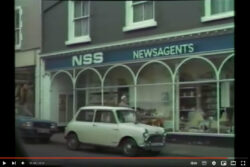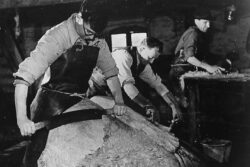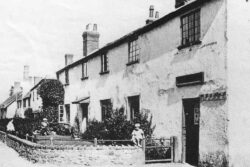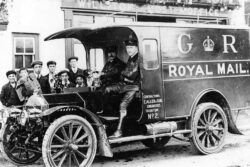Along a two mile footpath from Porlock Weir is the tiny settlement of Culbone listed in the Domesday book as Kytenore or Chetnore. Despite being small – literally seven houses and a church – it has much of interest for the historian within its parish boundary. The Culbone Stone Row situated in private woodland runs East/West for 1,200 feet near to the Porlock boundary.
There are thought to be 21 stones remaining but there may be more hidden in bracken and furze. 17 are in a straight line. They are all no higher than 3ft above ground. It is thought that the Culbone Stone was removed from this row and replaced in the 1940s along the trackway leading to Culbone Church. There is a permissive path to view this Standing Stone which is just over 3ft high and features an incised wheeled cross which indicates it is of C6 or C7 origin. It is made of Hangman Grit sandstone and is a scheduled ancient monument.
Culbone has been inhabited on and off since 3500 BC. Its remoteness made it an ideal place for ‘the banishment of social misfits’ and in the C13 ‘Disbelievers, the mentally insane and those practising witchcraft‘ were left here to fend for themselves without any support or resources.
The woods were used in the C14 as a colony for French soldiers and again in 1720 as a prison colony. They were also a site of the major charcoal burning industry. The original burners were reputed to have been lepers. They were not allowed into the village but there is a small leper window in the North wall of the church which enabled them to squint through to see inside and watch the service. It was installed after 45 lepers were banished to Culbone in 1544 and remained for 78 years until the last one died in 1622.
The window has now been glazed over with opaque glass.
Beside the A39 sit the Culbone Stables originally used for the stabling and exchange of coaching horses used on the Minehead to Lynmouth run. Soon after WW2 the Earl of Lytton, who had inherited the Lovelace Estate, converted the building in 1946 into a club known as Culbone Stables Inn, with a resident manager. By 1962 it had a full licence and hosted dances.
In the 1950s Rachel Reckitt (a British artist living in Old Cleeve who had been specialising in signs) was commissioned to create a sign for the Inn. It featured the Lorna Doone Coach and Four. It was built up in relief using sheet metal, wire or lead piping on a wooden core. Throughout the 1960s Rachel created sculptures in wood and stone as well as tombstones. She was taught wrought iron work by the Horrobins at Roadwater Smithy.
In the settlement around the Church three of the seven houses are listed – Culbone Cottage, Culbone Lodge, with its adjoining bridge over a sunken road, once the lodge for Ashley Combe (now demolished) and Parsonage Farm.
Two of Culbone’s best known inhabitants were Joan and Waistel Cooper. Joan, an American, with a Doctorate in Psychology married Waisel a potter in 1957 and they lived in a cottage in Culbone by a stream. Joan practised and taught Yoga for West Somerset Community Education. She was also a Lay Reader. She died on June 2nd 1982 and was buried in the little church’s cemetery. The whole area was packed for her funeral and a little dog sat by the edge of her grave during the service. Waistel, born in 1921 in Ayr, was instumental in the introduction of modernism into ceramics and was a major figure of the studio pottery scene. He set up in Culbone on his return from a commission in Iceland and worked in his studio there for 25years. Following Joan’s death he moved to Penzance in Cornwall and remarried. He died in 2003. His work commanded very high prices.
Now to that for which Culbone is best known today, its Grade I Listed church, considered to be the smallest most complete parish church in the country. The site of the church is a level spot of approximately a quarter of an acre, 400 feet above sea level and is surrounded by dark woodlands rising to 1,200 ft high.
The Reverend Richard Warner described the church as ‘The Lilliputian church of Culbone situated in as extraordinary a spot as man, in his whimsicality ever fixed on as a place of worship’.
It is dedicated to the Welsh saint St Beuno and pre-Norman in origin with a C13 porch and late C15 nave. Its bowl shaped font is probably Anglo Saxon. It has a reredos designed in 1927 by the Arts & Crafts architect CFA Vosey and made by Mr Huish. There is seating for a maximum of 40 people. Its little spirelet was added in 1888. One of its two bells is the oldest in West Somerset dating from the early C14. Originally, an independent parish church, it was merged with Oare in 1933 when the population of the entire parish amounted in 1931 to only 43. On an outside wall is the face of a Green Man surrounded by leaves symbolising the re-birth of new life every Spring. These first appeared in Europe in the C12 and often adorned churches in England. There is also evidence of a hermit or Anchorite’s cell on the North side of the church.
Services are still held here despite the fact that people have to walk a fair distance to it from whichever direction they approach. Those from the A39 turn north opposite The Culbone Stables and drive to Silcombe Farm, park and walk from there for approximately 25mins.
In 1760 a fair was held in the churchyard where there was dancing, skittle playing and much drinking amongst the gravestones.
Parsonage Farm now offers holiday accommodation in a secluded and fascinating spot. If you have never visited Culbone it is a must for the able bodied amongst you !
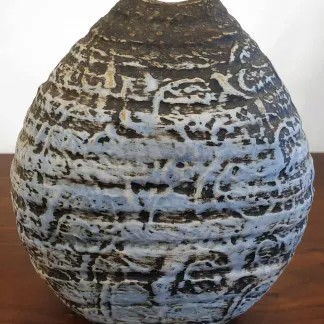
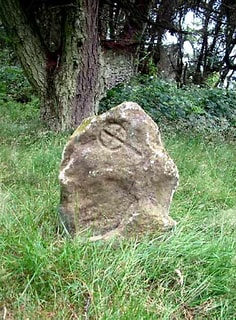
Compiled by Sally Bainbridge on behalf of Minehead Conservation Society.
Buy the book! Minehead & Beyond
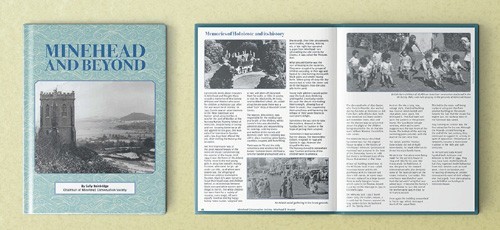
This book is a compilation of articles written for this magazine by Sally Bainbridge on behalf of Minehead Conservation Society. It contains information about the richness of West Somerset’s history; culture; people; heritage; traditions and beautiful and varied landscape. The book costs just £5 and all profits go to Minehead Conservation Society.
Available to buy from AR Computing, Park Lane Home Furnishing (in their Park Lane shop), Minehead Tourist Information Centre and Townsend House (Monday am).
Office: Townsend House, Townsend Road, Minehead TA24 5RG (01643 706258) E-mail: [email protected]
